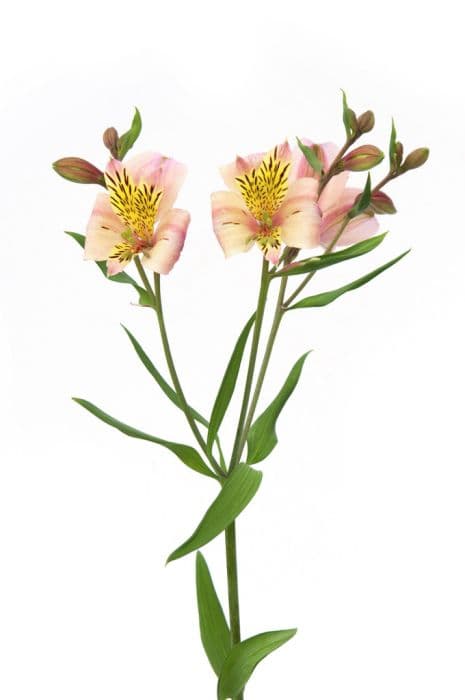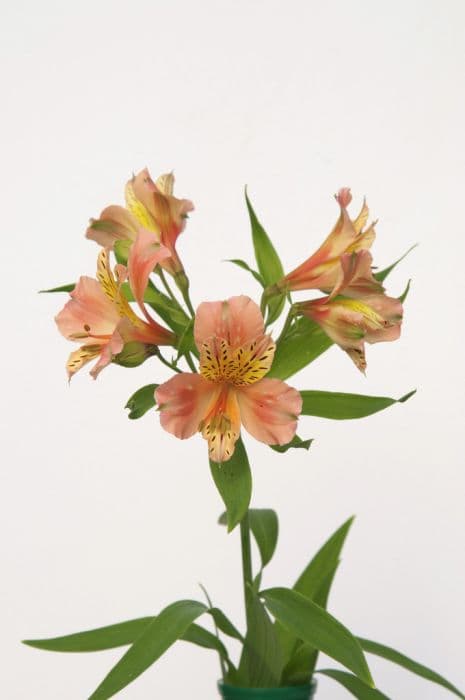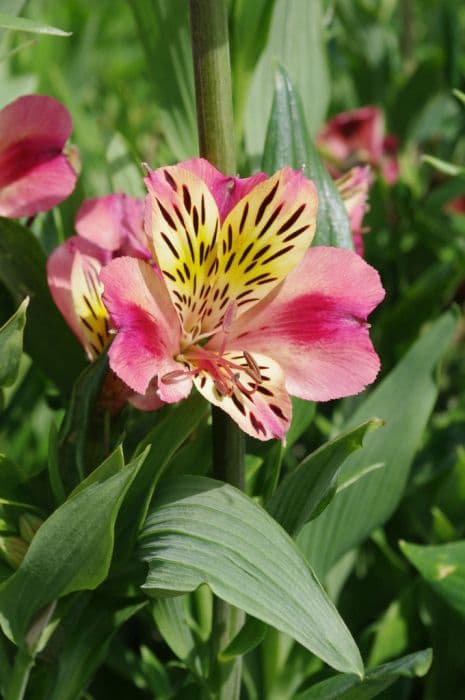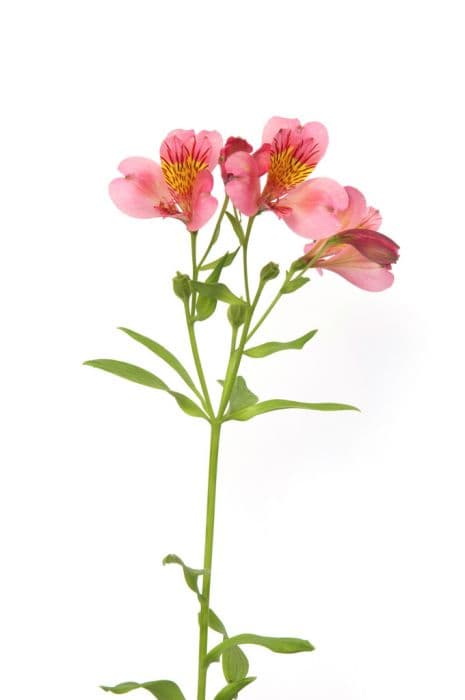Peruvian Lily Alstroemeria 'Pink Sensation'

ABOUT
Alstroemeria 'Pink Sensation' is a striking perennial known for its beautiful, showy flowers and robust nature. This plant produces clusters of delicate, trumpet-shaped blossoms that exhibit a vibrant pink hue, often adorned with darker pink to almost purple streaks or spots and a contrasting yellow to white throat. These flowers are symmetrical and feature six petals each, three of which may be slightly larger with a more rounded appearance, while the other three are narrower and often have a slight twist. The leaves of the 'Pink Sensation' are lance-shaped, with a dark green color that provides a lush backdrop for the bright flowers. The foliage may sometimes appear to spiral as it grows, adding an interesting textural element. Underneath, the leaves can have a lighter green shade and may show a silvery sheen. This plant typically blooms in the late spring through early fall, offering an extended season of visual interest. When in full bloom, the 'Pink Sensation' produces a prolific display of flowers that can be a point of attraction in gardens and floral arrangements. Capsules follow the flowers, containing small, black seeds that can be dispersed once the capsule splits open when mature. The plant exhibits a clumping growth habit, with clumps of stems that emerge straight from the soil and bear both the flowers and leaves. These stems are sturdy, supporting the flowers and allowing them to stand out prominently amidst the greenery.
About this plant
 Names
NamesFamily
Alstroemeriaceae
Synonyms
Peruvian Lily, Lily of the Incas, Parrot Lily
Common names
Alstroemeria 'Pink Sensation'.
 Toxicity
ToxicityTo humans
The Peruvian Lily, as Alstroemeria 'Pink Sensation' is commonly known, is not typically considered highly toxic to humans. However, it can cause minor skin irritations or allergic reactions in some individuals upon handling the plant. If ingested, parts of the plant may cause mild stomach upset, nausea, vomiting, or diarrhea. It is always advisable to wear gloves when handling plants with potential irritants and to avoid ingesting any part of ornamental plants.
To pets
The Peruvian Lily is generally considered to be non-toxic to pets, such as cats and dogs. However, just like in humans, if ingested, it may cause mild gastrointestinal upset, including vomiting or diarrhea in some pets. Although not known to be severely toxic, it's still best to prevent pets from eating ornamental plants as they might cause discomfort or more serious issues if consumed in large quantities.
 Characteristics
CharacteristicsLife cycle
Perennials
Foliage type
Semi-deciduous
Color of leaves
Green
Flower color
Pink
Height
2-3 feet (60-90 cm)
Spread
1-2 feet (30-60 cm)
Plant type
Bulb
Hardiness zones
7
Native area
South America
Benefits
 General Benefits
General Benefits- Long-Lasting Blooms: Alstroemeria 'Pink Sensation' has flowers that can last up to two weeks in a vase, making it a perfect choice for cut floral arrangements.
- Attractive Colors: The plant produces beautiful pink flowers that can add a splash of color to any garden or bouquet.
- Drought Tolerance: Once established, it can tolerate periods of drought, reducing the need for constant watering.
- Low Maintenance: It requires minimal pruning and is relatively pest and disease resistant.
- Continuous Flowering: This variety often blooms from late spring to early fall, providing color throughout the growing season.
- Attracts Pollinators: The flowers attract bees, butterflies, and other beneficial insects, promoting biodiversity in the garden.
- Versatility: It is suitable for garden beds, borders, and containers, offering flexibility in landscape design.
 Medical Properties
Medical PropertiesThis plant is not used for medical purposes.
 Air-purifying Qualities
Air-purifying QualitiesThis plant is not specifically known for air purifying qualities.
 Other Uses
Other Uses- Photography: The vibrant colors of this Alstroemeria, also known as Peruvian Lily, make it a popular subject for photographers, particularly those specializing in botanical and macro imagery.
- Eco-friendly Dye: The pigments from the petals of the Peruvian Lily can be used to create natural dyes for fabrics, offering an environmentally friendly option for textile coloring.
- Culinary Decoration: Though not commonly known for their edibility, the petals of the Peruvian Lily can be used as decorative elements in salads and desserts for an added touch of elegance.
- Art Inspiration: Artists may use the Peruvian Lily as a muse, capturing its form and color in various media such as watercolor, oil painting, or illustration.
- Teaching Aid: In educational settings, like schools or botanical workshops, the Peruvian Lily's diverse structure offers an example for lessons in botany, such as plant reproduction and petal arrangement.
- Flower Arranging Classes: The Peruvian Lily can be used in flower arranging courses to teach students about balance, color harmony, and the longevity of cut flowers in compositions.
- Crafting: The sturdy stems and long-lasting blooms of the Peruvian Lily are ideal for crafting, from creating decorative wreaths to adorning handmade greeting cards.
- Garden Photography Workshops: The Peruvian Lily, with its picturesque form, can be a subject in garden photography workshops where participants learn techniques for capturing the beauty of flowers.
- Bookmark Embellishment: Dried petals of the Peruvian Lily can be laminated and used as delicate bookmarks, adding a floral touch to the reading experience.
- Theme Parties: For garden or floral-themed events, the Peruvian Lily can be used to create a cohesive visual theme, from table centerpieces to venue decorations.
Interesting Facts
 Feng Shui
Feng ShuiThe Peruvian Lily is not used in Feng Shui practice.
 Zodiac Sign Compitability
Zodiac Sign CompitabilityThe Peruvian Lily is not used in astrology practice.
 Plant Symbolism
Plant Symbolism- Friendship: Peruvian lilies, commonly what Alstroemeria symbolizes, are often given as a token of friendship due to their long-lasting nature which reflects the enduring quality of a solid friendship.
- Devotion: Gifting Alstroemeria is seen as a representation of the dedication and mutual support found in a strong relationship, showing that one is willing to stand by and support their friend or partner through the trials of life.
- Wealth and prosperity: The flower's abundant petals and leaves are often associated with bringing a wealth of emotions or material wealth, suggesting that it can be a good omen for those seeking success and prosperity.
- Fortune: They can represent good fortune coming one's way, potentially due to their growth patterns and how they tend to spread easily, symbolizing the spread of positive energy.
- Health and longevity: The hardiness and resilience of the Alstroemeria plant can signify a wish for a person's health and longevity, drawing parallels from the flower's ability to endure in a variety of conditions.
 Water
WaterPeruvian Lilies, including the 'Pink Sensation' variety, require regular watering to keep the soil evenly moist but not soggy. During the growing season, water approximately once a week with about 1 gallon of water per square yard, depending on the climate and soil drainage. In hotter, drier conditions, more frequent watering may be necessary, while in cooler, wetter climates, water less often. Always check the top inch of the soil for dryness before watering again. Reduce watering in the winter when the plant is dormant.
 Light
LightPeruvian Lilies like 'Pink Sensation' thrive best in full sun to partial shade. Place them in a location where they can receive at least six hours of sunlight daily. Ideally, they prefer bright, indirect light or morning sunlight with some afternoon shade, especially in hotter climates where intense afternoon sun can be too much for the flowers.
 Temperature
TemperaturePeruvian Lilies, such as 'Pink Sensation,' prefer temperatures between 65 and 80 degrees Fahrenheit during the day and no lower than 40 degrees Fahrenheit at night. They can tolerate temperatures up to about 90 degrees Fahrenheit but may need protection or extra watering in extreme heat. Ideal growing conditions for the 'Pink Sensation' would involve avoiding exposure to temperatures below freezing, as they are not cold-hardy under 28 degrees Fahrenheit.
 Pruning
PruningPruning Peruvian Lilies, such as 'Pink Sensation,' helps promote vigorous growth and flowering. After the blooms have faded, cut the flower stalks back to the base to encourage new growth. Prune any dead or damaged stems throughout the growing season. The best time for major pruning is in late winter or early spring before new growth begins.
 Cleaning
CleaningAs needed
 Soil
SoilPeruvian lily 'Pink Sensation' thrives in well-draining soil with a mix of two parts loam, one part sand/grit, and one part peat or compost to maintain moisture without waterlogging. The soil pH should be slightly acidic to neutral, around 5.5 to 7.
 Repotting
RepottingPeruvian lilies should be repotted every 2-3 years or when they outgrow their current pot. It's best done after flowering or in early spring before new growth begins.
 Humidity & Misting
Humidity & MistingPeruvian lily 'Pink Sensation' prefers moderate humidity levels, consistent with typical indoor environments; aim for around 40-50% relative humidity.
 Suitable locations
Suitable locationsIndoor
Ensure bright, indirect light and protect from drafts.
Outdoor
Plant in a sheltered spot with partial shade.
Hardiness zone
7-10 USDA
 Life cycle
Life cycleThe life of the Peruvian Lily 'Pink Sensation' begins with the germination of seeds or development from tuberous roots, where it establishes a rosette of leaves. As the plant matures, it develops strong, upright stems which support a profusion of flowers, typically blooming from early summer through to late fall. After the blooming period, the flowers wither and the plant channels energy into the rhizomes for the next season's growth. During the winter months, the Peruvian Lily enters a dormancy period, especially in cooler climates, where it may die back to the ground. With the arrival of spring, new shoots emerge from the rhizomes, indicating the start of a new growth cycle. The plant continues to grow and multiply, with the clumps increasing in size annually, potentially requiring division every few years to maintain vigor.
 Propogation
PropogationPropogation time
Spring to early summer
Propogation: Alstroemeria 'Pink Sensation', commonly known as Peruvian Lily or Lily of the Incas, is most effectively propagated through division of its tuberous rhizomes. This process is best done in the spring as the plants emerge from dormancy, which gives the new divisions the full growing season to establish. When dividing the rhizomes, gardeners should carefully lift the clump from the ground and gently separate the rhizomes, ensuring that each division has at least one or two shoots or eyes. These divisions can then be replanted immediately at the same depth they were growing before, spaced about 12 to 18 inches (30 to 45 centimeters) apart to allow adequate room for growth. The soil should be well-draining and amended with organic matter to provide the best start for the new plants. With proper care, including consistent watering and mulching to retain soil moisture, the divisions will grow into new, flowering plants that will continue the beauty of 'Pink Sensation' in the garden.




![Peruvian lily [H.R.H. Princess Alice]](/_next/image?url=https%3A%2F%2Fplants-admin.emdemapps.com%2Fimages%2Fplants%2F%2Fimages%2F604b55e81c8b0.png&w=640&q=75)
![Peruvian lily [Indian summer]](/_next/image?url=https%3A%2F%2Fplants-admin.emdemapps.com%2Fimages%2Fplants%2F%2Fimages%2F604b616bc746b.png&w=640&q=75)
![Peruvian lily [Inticancha Creamy Dark Pink]](/_next/image?url=https%3A%2F%2Fplants-admin.emdemapps.com%2Fimages%2Fplants%2F%2Fimages%2F604b5e98bea7c.png&w=640&q=75)
![Peruvian lily [Inticancha Dark Purple]](/_next/image?url=https%3A%2F%2Fplants-admin.emdemapps.com%2Fimages%2Fplants%2F%2Fimages%2F604b5381bb78f.png&w=640&q=75)
![Peruvian lily [Inticancha Imala]](/_next/image?url=https%3A%2F%2Fplants-admin.emdemapps.com%2Fimages%2Fplants%2F%2Fimages%2F604b619b522ba.png&w=640&q=75)
![Peruvian lily [Inticancha Red]](/_next/image?url=https%3A%2F%2Fplants-admin.emdemapps.com%2Fimages%2Fplants%2F%2Fimages%2F604b5aebac273.png&w=640&q=75)